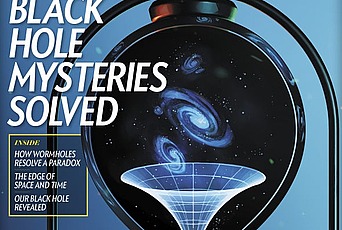Galactic ‘Lightsabers’: Answering Longstanding Questions About Jets from Black Holes
Press Contact
The one thing everyone knows about black holes is that absolutely everything nearby gets sucked into them.
Almost everything, it turns out.
“Even though black holes are defined as objects from which nothing can escape, one of the astonishing predictions of Einstein’s theory of relativity is that black holes can actually lose energy,” says Eliot Quataert, Princeton astrophysicist and current Member in the IAS School of Natural Sciences. “They can rotate, and just like a spinning top slows down over time and loses that energy in its rotation, a rotating black hole can also lose energy to its surroundings.”
Scientists have widely accepted this model since the 1970s. They knew that magnetic fields probably extracted energy from spinning black holes—they just didn’t know how.
A team of astrophysicists from IAS, Princeton University, and Vanderbilt University has now determined conclusively that energy close to the event horizon of M87’s central black hole is pushing outward, not inward. They have also created a way to test the prediction that black holes lose rotational energy, Quataert said, and to establish that this energy produces “the incredibly powerful outflows we see that we call jets.”

These energy outflow jets “are basically like million-light-year-long Jedi lightsabers,” said his former postdoctoral fellow Alexandru Lupsasca, and they can extend 10 times longer than the Milky Way galaxy.
The results of their work appear in the current issue of The Astrophysical Journal. Andrew Chael, an associate research scholar in astrophysics, is the first author on the paper. He and co-author George Wong, current Frank and Peggy Taplin Member in the School of Natural Sciences, are both members of the Event Horizon Telescope team and have played a critical role in developing the models that are used to interpret black holes.
The team gave Chael credit for the vital insight at the core of the new paper: that the direction in which the magnetic field lines are spiraling reveals the direction of the energy flow. From that, “the rest sort of fell into place,” Quataert said.
“If you took the Earth, turned it all into TNT and blew it up 1,000 times a second for millions and millions of years, that’s the amount of energy that we’re getting out of M87,” said Wong.
Scientists have known for decades that as a black hole starts to spin, it drags the fabric of spacetime around with it. Magnetic field lines that thread through the black hole get dragged along, and that slows down the rotation, leading to the energy release.
“Our new, sharp prediction is that whenever you look at an astrophysical black hole, if it has magnetic field lines attached to it, there will be energy transfer—truly insane amounts of energy transfer,” said Lupsasca, assistant professor of physics and mathematics at Vanderbilt University.
While the energy flow close to the event horizon of M87’s central black hole is streaming outwards, the team said that the energy flow could theoretically go inward in a different black hole. They are confident in their link between energy flow and the direction of the magnetic field lines, and their prediction that the energy flow comes from the black hole will be tested with the launch of the still-theoretical “next generation” Event Horizon Telescope.
For the past year and a half, black hole researchers around the world have been proposing specs for the future instrument, Wong said. "It is incredibly exciting! Linking energy outflow to such a simple observable like this is a critical step on the path to obtaining direct observational evidence of black hole energy extraction. I look forward to seeing what kind of robust statements we'll be able to make with the next generation of black hole images—and movies!"
The four researchers stressed in their paper that they haven’t conclusively shown that the black hole’s spin “truly powers the extragalactic jet,” though the evidence certainly leans in that direction. Even though the levels of energy that their model shows are commensurate with what the jets need, they couldn’t rule out the possibility that the jet could be powered by rotating plasma outside the black hole. “I think it’s extremely likely the black hole powers the jet, but we can’t prove it,” said Lupsasca. “Yet.”

This news is adapted from a press release issued by Princeton University.
About the Institute
The Institute for Advanced Study has served the world as one of the leading independent centers for theoretical research and intellectual inquiry since its establishment in 1930, advancing the frontiers of knowledge across the sciences and humanities. From the work of founding IAS faculty such as Albert Einstein and John von Neumann to that of the foremost thinkers of the present, the IAS is dedicated to enabling curiosity-driven exploration and fundamental discovery.
Each year, the Institute welcomes more than 200 of the world’s most promising post-doctoral researchers and scholars who are selected and mentored by a permanent Faculty, each of whom are preeminent leaders in their fields. Among present and past Faculty and Members there have been 35 Nobel Laureates, 44 of the 62 Fields Medalists, and 23 of the 26 Abel Prize Laureates, as well as many MacArthur Fellows and Wolf Prize winners.


